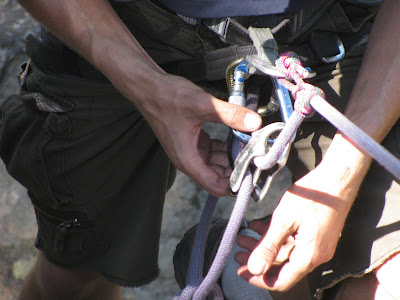I really wanted to do something fun for the Halloween blog today, but couldn't think of anything too unique, so I decided to watch a "Climbing Horror Movie."
You probably didn't think that was a genre. But I found one. And it was a doozy...
I really really wanted to like Blood Glacier. It's a horror movie that was actually shot in the mountains, with people who appear to know something about the mountains. It's a film where a climber could have suspended their disbelief...
...but the horror elements were so bad and the story was so hokey, that nobody else possibly could have.
There were several indicators that this film experience might not work out.
I know. I know.
The first and most obvious indicator was the title. But there were several other indicators in the first couple minutes of the movie. It was produced by IFC Midnight, which essentially is an indicator that it's going to be a B-level film from the get-go. Additionally, as the film opened, they showed glaciers and mountains, which would suddenly go from pristine to a filtered red at the same time they played jarring music.
Oh yeah, and the film was dubbed too. I think it might have been made by Germans...or something. It's hard to tell while watching it. But it was indeed shot in the Alps.
Click on the photo to expand it in its awful gory bloody glacierness.
A group of climate scientists are studying glaciers in a remote corner of the Alps. They discover that a glacier appears to bleeding. Unbeknownst to them, the "blood" coming from the glacier is mutating the local wildlife. Essentially the bacteria in the substance creates hybrid animals. If an animal ate something, the new hybrid would have characteristics of both the host and the thing the animal ate. And of course the hybrid is born the same way an alien from the Alien franchise is born, by bursting out of the host's body.
This presents a bit of a problem for the scientists. You know, because for some reason the prime minister is on her way up to the hut with the hero's ex-girlfriend and lots of other people to get attacked by hybrid blood glacier monsters.
This movie was bad enough that I don't really expect many of you to see it. So I'm going to spoil it for you. If you don't want it spoiled. Don't read another word.
It turns out that the hero and his girlfriend were going to have a baby. She had an abortion and regretted it. She wanted a baby with him...
Which is good because an infected dog licked the hero's blood and had a hyrbid dog-baby-thing burst out of it's stomach which the pair adopted as their own.
For some reason this doesn't seem very plausible.
My favorite line of the entire movie takes place when a woman who is sobbing is also eating a banana. The Prime Minister screams at her, "stop eating that banana while you're crying!" I did in fact laugh quite hard at that moment of the film...
So the story and the dialogue are both pretty laughable, but so are the monsters. It seems like we've been spoiled with monsters for several years on the big screen that look real. Some of these are done with CGI and others are done with puppetry and make-up. The most believable looking monsters actually use a combination of both.
The monsters in this movie are so bad that it's hard not to laugh at them. They look like something that a high school drama scene shop with no budget might produce for a teenage haunted house. They're terrible...and kind of funny.
I really really wanted to like Blood Glacier, but I didn't. The hokiness provided some laughs, but it wasn't really worth an hour and a half of my time...
--Jason D. Martin

















